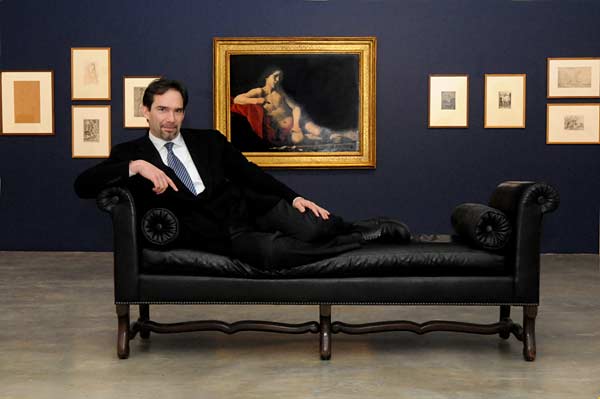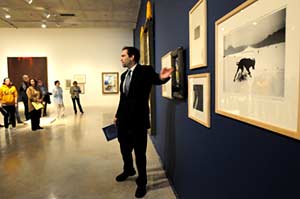 Lawrence Rinder poses a la Giovanni Caracciolo's The Young Saint John in the Wilderness (1610), one of the works featured in BAM/PFA's new exhibit, Galaxy: A Hundred or So Stars Visible to the Naked Eye. (Peg Skorpinski photo)
Lawrence Rinder poses a la Giovanni Caracciolo's The Young Saint John in the Wilderness (1610), one of the works featured in BAM/PFA's new exhibit, Galaxy: A Hundred or So Stars Visible to the Naked Eye. (Peg Skorpinski photo)In a Galaxy not all that far away…
Stellar works are showcased in a new BAM/PFA exhibit
| 4 March 2009
 BAM/PFA Director (and Galaxy curator) Lawrence Rinder illuminates three works in the new exhibit. (Peg Skorpinski photo)
BAM/PFA Director (and Galaxy curator) Lawrence Rinder illuminates three works in the new exhibit. (Peg Skorpinski photo)BERKELEY —Galaxy: A Hundred or So Stars Visible to the Naked Eye, a new exhibit at the Berkeley Art Museum, opens up otherworldly vistas, inviting visitors to make discoveries about the institution's 15,000-piece art collection, from which the works in the exhibit were drawn. The show — which fills three galleries — spans the 14th to the 21st centuries with works by Romare Bearden, Elliott Erwitt, Paul Gauguin, Paul Klee, Zoe Leonard, René Magritte, Jackson Pollock, Mark Rothko, and Peter Paul Rubens (among others) in a variety of media.
Lawrence Rinder, director of the Berkeley Art Museum and Pacific Film Archive, curated the show, his first since taking the helm at the museum in July 2008. To assemble Galaxy, Rinder spent days sorting through flat files of drawings and viewing art stored in crates in the museum's warehouse. The undertaking gave him the opportunity to revisit art he first came to know as BAM/PFA's MATRIX curator from 1988-98 and to acquaint himself with acquisitions that had been made in his absence.
 Galaxy's constellation of works includes (from top to bottom) Number 6 (Jackson Pollock,1950); Flying Female Figure (Giovanni Battista Tiepolo, 1739-49); and New York (Helen Levitt.,1942).
Galaxy's constellation of works includes (from top to bottom) Number 6 (Jackson Pollock,1950); Flying Female Figure (Giovanni Battista Tiepolo, 1739-49); and New York (Helen Levitt.,1942). "I love the peculiarities and eccentricities of specific collections, and this is one I happen to really adore," says Rinder. BAM/PFA's collection began in 1963 with the gift of 47 Hans Hofmann abstract paintings. Hofmann, who taught summer sessions at Berkeley in 1930-31, gave the works on the condition that the university would promise to construct a museum on campus. Peter Selz, the museum's first director, had the foresight to acquire other pieces to contextualize the Hofmann gift, including works by such abstract expressionists as Mark Rothko, Sam Francis, Ad Rinehart, and Clyfford Still.
In the warehouse, Rinder encountered some surprises, including Karuna (1966), a welded-brass sculpture by Ibram Lassaw (1913-2003), an artist-in-residence and guest professor of art practice at Berkeley during the mid-1960s. The sculpture, which balances on three legs, resembles a delicate, mangled chair with a protruding trumpet horn. "I can see why it's been in storage for so long but I love it," says Rinder. "It feels very appropriate to our moment."
Finger on the pulse
Rinder learned the importance of being attuned to the present early in his career. After receiving an M.A. in art history from Hunter College, he worked as an arts educator in the New York City public-school system. In his initial months on the job he tried to impose his notions of art history on middle- and high-school students by extolling the greatness of Cézanne's brushstroke.
"I took my life into my hands with that approach," he laughs, recalling the students either fell asleep or got angry. To engage them, he learned how to communicate why such subjects matter in the present. Helping people connect with art has to do with "how you install the work, what art you choose, what relationships you make, and what you write about it," explains Rinder.
In Galaxy's gallery guide, short text about some of the pieces touch on aspects of the work that might be of interest to a broader, more contemporary audience — rather than providing a "typical art-historical rationale for why these things are here," says Rinder.
By way of example, he mentions a painting by Puvis de Chavannes, "a wonderful and yet somewhat obscure French academic painter." The painting, says Rinder, is based on a novel by Longus, a Greek who wrote only one known work, Daphnis and Chloe. "All of that is very dull to hear," notes Rinder. "But when you find out that Daphnis and Chloe by Longus inspired the 1987 film The Princess Bride, suddenly the painting might open up to you in a different way."
Rinder chose to install Galaxy's works in salon-style groups, rather than isolating each one, a more conventional approach. "I think that the particular combinations draw out aesthetic qualities from the works that wouldn't be as evident — resonances, harmonies — if they were displayed singularly," he explains.
The show's juxtapositions also suggest Rinder's experience of sifting through pieces in the museum's warehouse, where art isn't stored according to chronology or specific school. Galaxy's arrangement also hints at the richness and breadth of BAM/PFA's collection, says Rinder. The exhibit's 150-plus works represent a fraction of the museum's permanent collection.
"Even people who are familiar with the museum might not be aware what an extraordinary collection of Old Master prints, paintings, and drawings, and Italian Baroque paintings we have," observes Rinder. And BAM/PFA's collection of Chinese paintings from the Ming and Ching dynasties outshines those of many Asian art museums, he says. "In terms of scale, quality, and breadth, we have one of the best university collections in the country."
Curating Galaxy afforded Rinder "a very personal exploration of the BAM collection." The show, he says, includes "a lot of disturbing art but also a lot of work that is extremely beautiful, hope-filled, humorous." Rinder would like the exhibit not only to remind visitors of the museum's "super-abundance of art" but also to leave them feeling "like they're inspired to go make a painting."
Galaxy is on view through Aug. 30. For information, visit bampfa.berkeley.edu.

